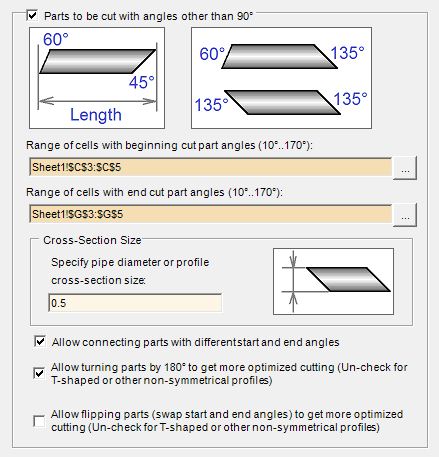
The dialog specifies the range of cells containing part cutting angles definitions.
1DCutX assumes all cuts start at the bottom side of stocks and go to the top side. Therefore angles are measured from the bottom point (cut’s start) of stocks and go counterclockwise direction toward a top point (cut’s end). Allowed range of angles is from 10° to 170°.
The cross-section size is used to calculate the horizontal cutting difference according the formula:
HorizDif = CrossSection * Tangency(Angle – 90°)
If HorizDif is negative then the top point (cut’s end) is located on the right side of the bottom point (cut’s start). This happens for angles less than 90°. If HorizDif is positive then top point (cut’s end) is located on the left side of the bottom point (cut’s start). This happens for angles bigger than 90°.
The numeric values can be specified in different formats (decimal, fractional or Imperial units). Click here to read more about supported formats.
Mandatory range cells containing cutting angles for the beginning (left side) of the parts.
Mandatory range cells containing cutting angles for the end (right side) of the parts.
Mandatory value that defines the pipe’s diameter or beam’s width. This value together with angles defines a horizontal difference from the bottom point (cut’s start) toward the top point (cut’s end).
Different parts in your project could have different cutting angles. You can check-off this box to allow cutting parts with different adjacent angles.
For example, the first part has end cut angle of 60° and the second one has beginning cut angle of 45°. If this box is un-checked then 1DCutX could place the second part after the first one. If you check this box then second part must have beginning angle of 60°.
If you set this box checked then optimization engine has more flexibility and the results will be more optimized.
This is an example of a cutting layout when the check box is un-checked:

This is an example of a cutting layout when the check box is checked:

When you cut non-symmetrical stocks, such as profile beams it’s important to preserve the cutting angles as they specified. If you cut symmetrical stock, such as pipe, bars or tubes the cutting angles can be turned by 180° to get more optimized results.
For example, the first part has end angle of 60° and the second part has beginning angle of 120°. Cutting the second part after the first will produce some material waste. However, if we turned the second part upside-down (by 180°) then the start angle would become 60° and there would be no waste during the cutting.
Bottom line - if you cut symmetrical stocks leave this box checked.
This is an example of a cutting layout when the check box is checked:

Note: Angles in the bracket have been rotated. If the original angle was 45° then when a part gets rotated the angle became (135°).
This option allows flipping parts by swapping/exchanging their start and end angles. Together with allow rotating options it can produce more optimized results.
For example, the parts have start angle of 45° end angle of 90°. Without flipping it produces the following layout:

If we flip the first part and rotate the second part upside-down (by 180°) then the following layout produced:

Note: Square brackets indicate the part has been flipped and angles have been modified as well. The original angle was 45° then when a part gets rotated the angle became 135°.